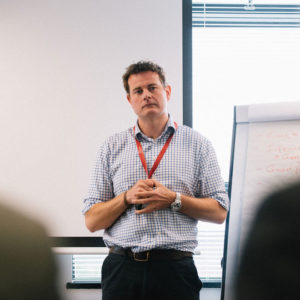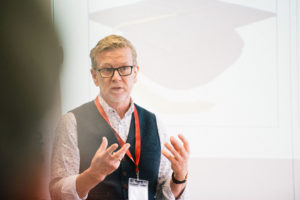JFPM Meeting Report: FPM Education Day 2019
Posted on: Tuesday 6 August 2019
The special edition of the Journal of the Faculty of Pharmaceutical Medicine is a collection of articles written by attendees of FPM Education Day 2019. The event was held on 12 June 2019 at NCVO Kings Cross and was themed around Patients in the Practice of Pharmaceutical Medicine.
Help your trainee take the patient perspective
 By Dr Lucy Cook, Independent Pharmaceutical Physician, Wiltshire Pharma Ltd
By Dr Lucy Cook, Independent Pharmaceutical Physician, Wiltshire Pharma Ltd
The workshop ‘Help your trainee take the patient perspective’ was run by Dr Liz Clark and Alastair Duns, an expert patient. The workshop was aimed at Educational Supervisors in pharmaceutical medicine.
This thought-provoking workshop was a practical consideration of the drivers for the need for taking the patient perspective in our work, as well as review of the Pharmaceutical Medicine Specialty Training (PMST) curriculum components where the patient perspective is important.
We concluded that we find ourselves in a time of well-informed patients who have access to more information than ever before, but this is coupled with an underlying mistrust of our industry and a demand for transparency.
We considered the dangers of interacting with patients; we must certainly never promote to the public, but there are activities that we can compliantly undertake. We can listen, and we can engage with patients as experts in their experiences.
We identified numerous points throughout the PMST curriculum where pharmaceutical medicine trainees can be encouraged to consider the patient perspective with reflection on how to involve patients; disease management guidelines, health economics, recall guidance for patients, study design with study endpoints and informed consent being of importance, but there are many more than we realised.
Sharing our experiences, we learned that listening to patients can be highly informative, but we must ensure that the engagement is maintained over time and appreciated. Without any thanks or updates, patients will be left feeling under-valued and “used”.

Patient engagement in study design
 By Dr Anil Abeyewickreme, Senior Medical Advisor, GlaoxSmithKline
By Dr Anil Abeyewickreme, Senior Medical Advisor, GlaoxSmithKline
The ‘Patient engagement in study design’ workshop was led by Dr Guy Yeoman and Mr Mitch Silva, two industry veterans who have worked together providing leadership to patient engagement projects across the pharmaceutical industry.
The session started with a presentation by Guy and Mitch demonstrating patient engagement is the key to generating high quality data in a fast and effective manner in clinical studies. Patient engagement must begin at the outset of study design and continue after a study is completed. The central tenet of the approach is putting patients at the heart of all decision making around the study and ensuring a two-way conversation as the study proceeds. This could involve gaining expert patient opinion or use of digital technologies to gain feedback on study experience.
When patients are consulted and engaged in discussions around the study they are more willing to get involved, contributing to faster recruitment. Patients are also more motivated to attend study visits and participate fully in contributing to higher quality and complete data. When patients are informed about the progress of the study they have greater ownership of the results and are important contributors to successful reimbursement and launch of an asset.
Clearly patient engagement needs to be at the forefront of our considerations to enable fast delivery of high-quality cost-effective research.
Social media: Balancing patient expectations with compliance
 Dr Mayura Deshpande, Senior Medical Manager, Lundbeck Ltd
Dr Mayura Deshpande, Senior Medical Manager, Lundbeck Ltd
Social media is the primary method of communication for many people around the world; from teenagers exchanging messages on Snapchat to demonstrators broadcasting their cause to the world. Social media is constantly evolving as developers create new platforms and users find more ways of using them. Social media can be defined in more than 50 ways, which shows how broad the topic is. We can define social media as an internet-based tool that allows people to share and discuss content, for example.
We can also look at the use of social media from different perspectives. For patients, there is a wealth of detailed and complex information available to them on the internet, which can be overwhelming and difficult to understand. It is also used as an area to seek advice and support, particularly from wider community forums. From the industry perspective, there is an increasing need to be cautious when using social media as there is little guidance available on how to ensure the information published is acceptable.
Patients are at the centre of what we do as pharmaceutical physicians. Our engagement with patients through social media can be used to many things such as conducting a hypothesis generation study to find out what is relevant and matters most to patients.
The workshop ‘Social media: Balancing patient expectations with compliance’, which was run by Dr Asad Khan and Jane Leahy, a patient expert, made me realise that social media is a big topic and that its use is not restricted by national boundaries and the patients’ access to information is global. As pharmaceutical physicians, what is needed from us is to look at various opportunities that come from the use of social media and maintain balance between patient needs and company strategies while keeping in mind our responsibilities.
Writing in Plain English: Creating Effective Lay Versions of Technical Documents
By Dr Cecilia Chisholm, Medical Assessor, MHRA
This workshop was led by two facilitators with very different backgrounds. The session was opened by Ms Trishna Bharadia, a patient and health advocate, who was diagnosed with multiple sclerosis over 10 years ago. She highlighted the problems with current lay documents and detailed the content of a good lay summary. Each patient should be able to determine the relevance of the trial population, the trial outcome, if the intervention is available now and where to obtain further information. Challenges include the pervading culture within companies, individual training, cost and finding ‘appropriate’ patients to write and review the documents.
Theo Raynor, Professor of Pharmacy Practice at Leeds and founder of a communication and user testing company provided useful tips on writing the documents in an accessible way. Pointers include:
- be conversational,
- use bullet points,
- not ALL CAPITALS, and
- be careful with pictures as these can be interpreted in unique and unpredictable ways.
We were then split into groups and tasked with re-writing sections of a European public assessment report (EPAR). Unsurprisingly, there was much debate on the optimum, appropriate wording and no group was close to presenting a finished paragraph.
I found this workshop useful to explore how patients would like information to be presented. We all know about ‘patient friendly’ documents but what this means is more nebulous. The aim is not to remove complicated concepts around trial design or benefit risk but to explain these logically in a manner that can be understood by a typical 12-year old. For me going forward, taking ownership of patient-orientated documents is important. It is easy for multiple people to implement changes so that tone of the final version is fragmented and inconsistent. Read the document, preferably out loud, and check if it makes sense!

